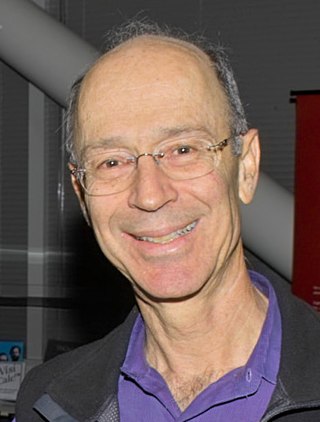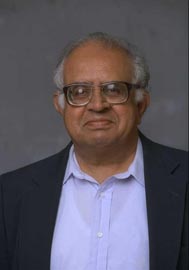Pattern recognition is the task of assigning a class to an observation based on patterns extracted from data. While similar, pattern recognition (PR) is not to be confused with pattern machines (PM) which may possess (PR) capabilities but their primary function is to distinguish and create emergent pattern. PR has applications in statistical data analysis, signal processing, image analysis, information retrieval, bioinformatics, data compression, computer graphics and machine learning. Pattern recognition has its origins in statistics and engineering; some modern approaches to pattern recognition include the use of machine learning, due to the increased availability of big data and a new abundance of processing power.

Peter Gabriel Neumann is a computer-science researcher who worked on the Multics operating system in the 1960s. He edits the RISKS Digest columns for ACM Software Engineering Notes and Communications of the ACM. He founded ACM SIGSOFT and is a Fellow of the ACM, IEEE, and AAAS.

SRI International (SRI) is an American nonprofit scientific research institute and organization headquartered in Menlo Park, California. The trustees of Stanford University established SRI in 1946 as a center of innovation to support economic development in the region.

Elwyn Ralph Berlekamp was a professor of mathematics and computer science at the University of California, Berkeley. Berlekamp was widely known for his work in computer science, coding theory and combinatorial game theory.
Robert M. Haralick is Distinguished Professor in Computer Science at Graduate Center of the City University of New York (CUNY). Haralick is one of the leading figures in computer vision, pattern recognition, and image analysis. He is a Fellow of the Institute of Electrical and Electronics Engineers (IEEE) and a Fellow and past president of the International Association for Pattern Recognition. Professor Haralick is the King-Sun Fu Prize winner of 2016, "for contributions in image analysis, including remote sensing, texture analysis, mathematical morphology, consistent labeling, and system performance evaluation".

Shakey the Robot was the first general-purpose mobile robot able to reason about its own actions. While other robots would have to be instructed on each individual step of completing a larger task, Shakey could analyze commands and break them down into basic chunks by itself.
In a statistical-classification problem with two classes, a decision boundary or decision surface is a hypersurface that partitions the underlying vector space into two sets, one for each class. The classifier will classify all the points on one side of the decision boundary as belonging to one class and all those on the other side as belonging to the other class.
Grammar induction is the process in machine learning of learning a formal grammar from a set of observations, thus constructing a model which accounts for the characteristics of the observed objects. More generally, grammatical inference is that branch of machine learning where the instance space consists of discrete combinatorial objects such as strings, trees and graphs.

Thomas M. Cover [ˈkoʊvər] was an American information theorist and professor jointly in the Departments of Electrical Engineering and Statistics at Stanford University. He devoted almost his entire career to developing the relationship between information theory and statistics.

Peter E. Hart is an American computer scientist and entrepreneur. He was chairman and president of Ricoh Innovations, which he founded in 1997. He made significant contributions in the field of computer science in a series of widely cited publications from the years 1967 to 1975 while associated with the Artificial Intelligence Center of SRI International, a laboratory where he also served as director.

Rangasami Lakshminarayan Kashyap was an Indian applied mathematician and a Professor of Electrical Engineering at Purdue University.
Bir Bhanu is the Marlan and Rosemary Bourns Endowed University of California Presidential Chair in Engineering, the Distinguished Professor of Electrical and Computer Engineering, and Cooperative Professor of Computer Science and Engineering, Mechanical Engineering and Bioengineering, at the Marlan and Rosemary Bourns College of Engineering at the University of California, Riverside (UCR). He is the first Founding Faculty of the Marlan and Rosemary Bourns College of Engineering at UCR and served as the Founding Chair of Electrical Engineering from 1/1991 to 6/1994 and the Founding Director of the Center for Research in Intelligent Systems (CRIS) from 4/1998 to 6/2019. He has been the director of Visualization and Intelligent Systems Laboratory (VISLab) at UCR since 1991. He was the Interim Chair of the Department of Bioengineering at UCR from 7/2014 to 6/2016. Additionally, he has been the Director of the NSF Integrative Graduate Education, Research and Training (IGERT) program in Video Bioinformatics at UC Riverside. Dr. Bhanu has been the principal investigator of various programs for NSF, DARPA, NASA, AFOSR, ONR, ARO and other agencies and industries in the areas of object/target recognition, learning and vision, image/video understanding, image/video databases with applications in security, defense, intelligence, biological and medical imaging and analysis, biometrics, autonomous navigation and industrial machine vision.

Jón Atli Benediktsson is the rector and president of the University of Iceland and professor in electrical and computer engineering at the university. His research fields are remote sensing, image analysis, pattern recognition, machine learning, data fusion, analysis of biomedical signals and signal processing. He has published over 400 scientific articles in these fields and is one of the most influential scientists in the world according to Publons’ lists in 2018 and 2019.

Jagdishkumar Keshoram Aggarwal is an American computer scientist, who is currently retired and is Cullen Trust Endowed Emeritus Professor of the Department of Electrical and Computer Engineering at the Cockrell School of Engineering, University of Texas at Austin. He is known for his contributions in the fields of computer vision, pattern recognition and image processing focusing on human motion and activities. He served in various positions in the Department of Electrical and Computer of the University of Texas at Austin and other institutions.
Edwin Hancock, FREng was a British computer scientist at the University of York who specialised in computer vision and pattern recognition.

René Vidal is a Chilean electrical engineer and computer scientist who is known for his research in machine learning, computer vision, medical image computing, robotics, and control theory. He is the Herschel L. Seder Professor of the Johns Hopkins Department of Biomedical Engineering, and the founding director of the Mathematical Institute for Data Science (MINDS).
Jianchang (JC) Mao is a Chinese-American computer scientist and Vice President, Google Assistant Engineering at Google. His research spans artificial intelligence, machine learning, computational advertising, data mining, and information retrieval. He was named a Fellow of the Institute of Electrical and Electronics Engineers (IEEE) in 2012 for his contributions to pattern recognition, search, content analysis, and computational advertising.
Jason Joseph Corso is Co-Founder / CEO of the computer vision startup Voxel51 and a Professor of Robotics, Electrical Engineering and Computer Science at the University of Michigan.

David G. Stork is a scientist and author, who has made contributions to machine learning, pattern recognition, computer vision, artificial intelligence, computational optics, image analysis of fine art, and related fields.










